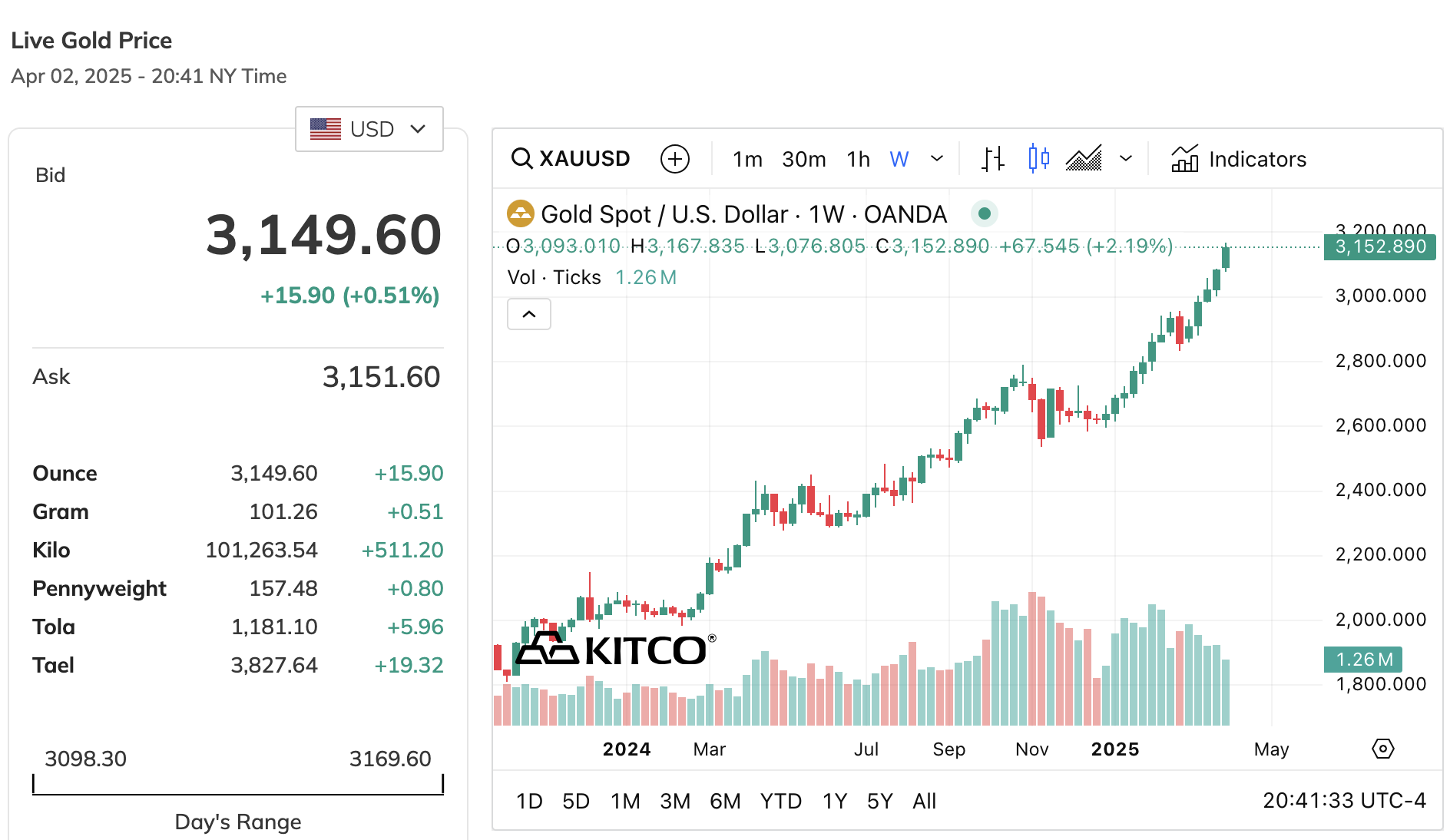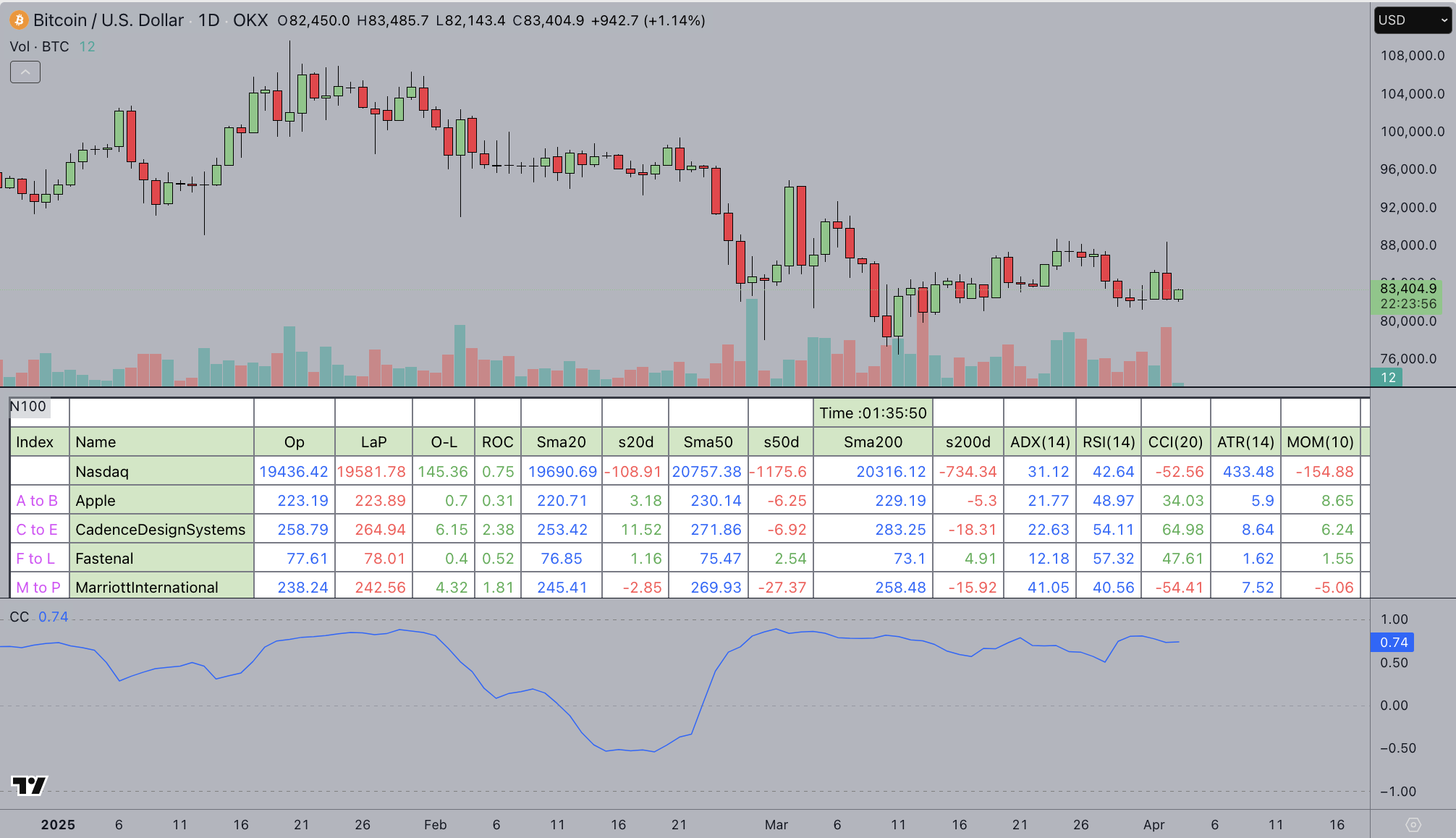- The President of the United States, Donald Trump, has introduced new tariffs aimed at the UK and Israel, causing fluctuations in global markets.
- Bitcoin’s value fell to around $82,000 on Wednesday, reflecting a 3% decrease from its daily high of $87,400.
- Gold surged to an unprecedented high of $3,152, marking a 10% increase since Trump announced the start of tariffs in early March.
The price of Bitcoin has sharply decreased towards $82,000 as gold prices have risen above $3,150 following Trump’s tariff announcements on Israel and the UK, stirring turbulence in global markets.
Global markets dip as Trump’s tariffs extend uncertainty
U.S. President Donald Trump has declared extensive tariffs on imports from the United Kingdom, Israel, and several other countries, resulting in market volatility worldwide.
This action, described as a “Declaration of Economic Independence,” has prompted contrasting reactions in the prices of Bitcoin (BTC) and Gold.
While Bitcoin fell to $82,143, representing a 3% drop from its peak of $87,400 earlier in the day, gold (XAU) prices surged to a record high of $3,152 per ounce, having risen 10% since Trump made the initial tariff announcement in early March.
On Wednesday, the President revealed a detailed list of reciprocal tariffs impacting multiple countries, including:
- China: 34%
- European Union: 20%
- United Kingdom: 10%
- Israel: 17%
- India: 26%
- Japan: 24%
- South Korea: 25%
- Vietnam: 46%
- Taiwan: 32%
- Thailand: 36%
During his address at the White House, Trump asserted that the U.S. has been treated unjustly in global trade agreements for many years.
“April 2, 2025, will always be remembered as the day American industry was reborn, the day America’s destiny was reclaimed, and the beginning of our journey to Make America Wealthy Again,”
– U.S. President Donald Trump announces new tariffs, April 2, 2025
These tariffs, meant to safeguard domestic industries, have triggered a mixed reaction in the markets; U.S. stocks have declined, commodities like Gold have rallied, and cryptocurrencies are under short-term selling pressure.
Bitcoin (BTC) drops 3% below $83,000
Following the tariff announcement, Bitcoin experienced substantial selling pressure, sinking to a two-week low of $82,143 before settling around $83,187.
This represents a 7% decline from its recent high of $88,060 reached on March 26.
Bitcoin Price Movement Following Tariff Announcement, April 2, 2025
The decline indicates investor apprehension regarding rising trade tensions and the potential broader impacts of the tariffs on risk assets. Amid increasing economic uncertainty, traders are shifting their focus from speculative investments to more traditional safe-haven assets like Gold.
Gold (XAU/USD) surges past $3,150
In contrast to Bitcoin, gold prices have surged, surpassing the $3,150 threshold for the first time. Spot gold traded at $3,128 per ounce, and U.S. gold futures settled at $3,152.
 Gold Price Movement Following Tariff Announcement, April 2, 2025
Gold Price Movement Following Tariff Announcement, April 2, 2025
This marks a 10% increase since early March, when Trump first suggested the imposition of tariffs.
The rise in gold prices underscores its reputation as a reliable safe haven against economic instability and inflationary pressures in today’s financial landscape.
Long-term Outlook: Diverging routes for Bitcoin and Gold amid U.S. corporate exposure
The contrasting responses of Bitcoin and gold prices on Wednesday illuminate shifting investor sentiment driven by geopolitical and macroeconomic changes.
Gold’s increase reflects a safe-haven flight as investors seek reliability in tangible assets amid growing economic uncertainties.
Traditionally viewed as “digital gold,” Bitcoin’s recent behavior suggests a rising correlation with U.S. equities.
Currently, Bitcoin’s correlation to the Nasdaq 100 index stands at 0.74%. If the top 100 U.S. tech stocks decline by 10%, Bitcoin is expected to drop by about 7.4%, and vice versa. However, with the ongoing influence of Trump’s tariffs, a bearish trend seems more likely.
Bitcoin (BTC) Correlation to Nasdaq 100 Index | April 2, 2025
This progression relates to the increasing engagement of the U.S. Government with the cryptocurrency market and the direct exposure of publicly traded companies like Blackrock and Microstrategy.
This places Bitcoin’s short-term price trajectory at risk, particularly if U.S. stocks continue their downward trend as affected nations deliberate on retaliatory and diplomatic actions in the coming days.
The next few weeks will prove critical in determining whether Bitcoin can assert itself as a genuine hedge against economic turmoil or remain closely tied to U.S. tech stocks for the foreseeable future.

